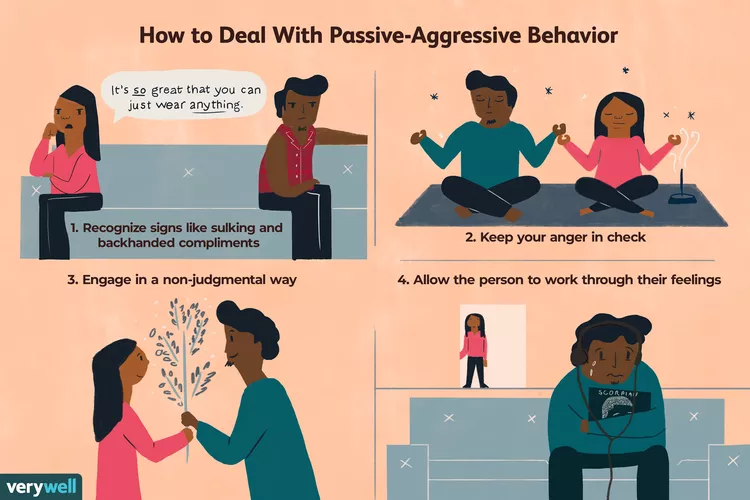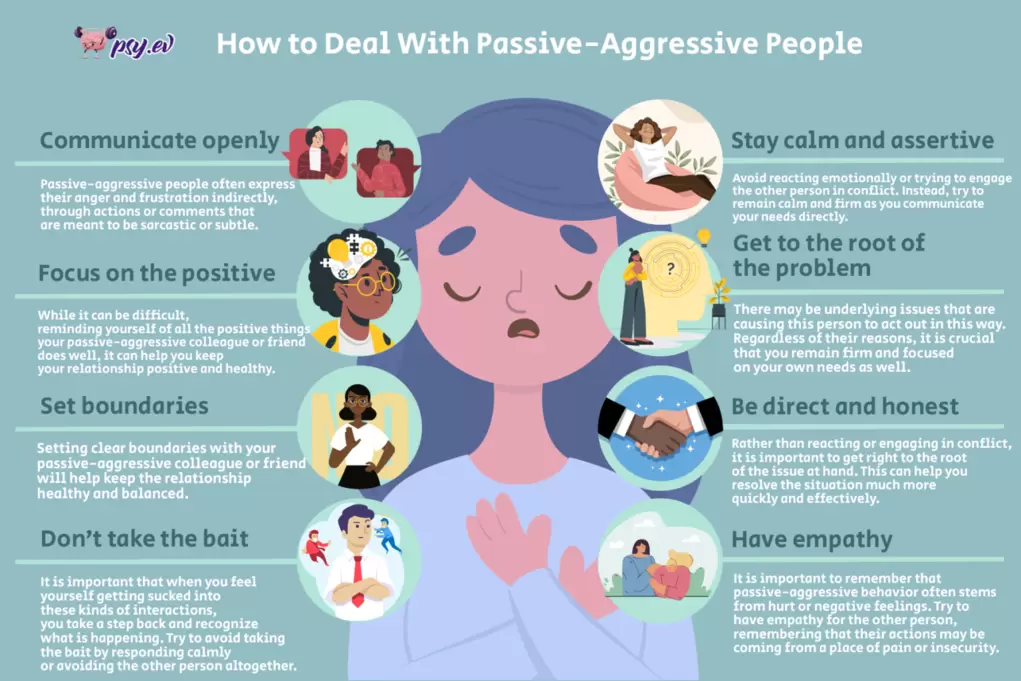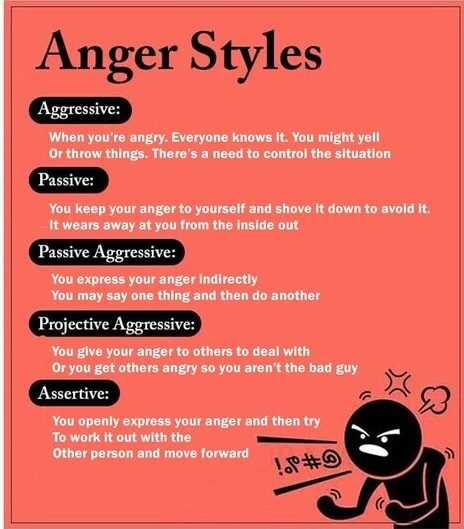
WHAT IS PASSIVE AGGRESSIVE BEHAVIOUR
What is passive-aggressive behavior? What are some of the signs?
Passive-aggressive behavior is a pattern of indirectly expressing negative feelings instead of
openly addressing them.
For example, someone who engages in passive-aggressive behavior might appear to agree — perhaps even enthusiastically — with another person’s request. Rather than complying with the request, however, he or she might express anger or resentment by failing to follow through or missing deadlines.
Specific signs of passive-aggressive behavior include:
- Resentment and opposition to the demands of others, especially the demands of people in positions of authority
- Resistance to cooperation, procrastination and intentional mistakes in response to others’ demands
- Cynical, sullen or hostile attitude
- Frequent complaints about feeling underappreciated or cheated
it is vital that we take a long look at ourselves before we start poking into our kids’ thoughts. We need to ask ourselves, “Do we display passive aggressive behavior?”
Often, passive aggressive behavior is a learned trait. When our kids get angry, they act on what they’ve seen.
Passive aggressive behavior, is not a phase. It is not something that will just pass in time.
It is a habit.
It is a way your child has learnt to expressing themselves. It is actually a control mechanism on their part.
Passive-Aggressive individuals share four common traits:
They are unreasonable,
they are not open to new experiences,
they rarely express their hostility directly and
they repeat their destructive behavior over time.
Passive-aggressiveness is directed toward either a person or a group.TYPES OF PASSIVE AGGRESSIVE BEHAVIOUR
1.Disguised Verbal Hostility – this comes in the form of negative gossip, veiled hostile joking and most often, sarcasm. Usually, people follow these remarks with “just kidding.” Repetitive teasing is also a sign that the individual is passive aggressive. He has a negative orientation and habitually criticizes the ideas, conditions, solutions and expectations of other people.
2.Disguised Relational Hostility – in other words, this is also known as the silent and invisible treatment. They exclude themselves. They are also prone to neglecting and backstabbing other people as well as sending out mixed messages and deliberately pushing other people’s buttons. They love negative and discomforting surprises. They overspend, hold on to resentment and indirectly hurt something or someone that is important to the person that they are targeting.
3.Disguised Task Hostility – also known as procrastination, stalling, forgetting, and stonewalling. They withhold resources and information and exclude details. They also deny responsibility and make excuses for their actions by blaming others. They break agreements and consistently fail to follow through. They are resistant, stubborn, rigid, and avoid tasks. They are inefficient and complicated.
4.Hostility Towards Others Through Self-Punishment – this makes them quit and deliberately fail in tasks that they participate in. They exaggerate and imagine health issues. They are constantly in a state of being a victim. They are so dependent, addictive and constantly harming themselves. They deliberate weakness so that they can elicit favor and sympathy.
The 2-Minute Action Plan for Parents
- Do you show passive aggressive behavior in your daily relationships?
- Do you suspect your child may be showing passive aggressive behavior? What ‘level’ do you think your child is at?
- Do you express your emotions in a healthy form?
- Do you encourage your children to ‘feel’?
WHAT TO DO
ØKeep your cool – don’t overreact – don’t let it get to you
ØKeep it at a distance – simply agree to disagree. You wont win with a passive aggressive
ØReflect – you cannot change them – so look at your behaviour – is this something you do
ØDo not engage with volleying – tit for tat – let it drop on the floor
ØJust do not argue – be the powerful silent presence – remain calm cool and collected
ØUse humour when you can
ØAvoid letting them slip into victim mode – never direct argument at them – Use I words or we
ØDefuse the resistance – regard them as high functioning individuals and don’t buy into their drama

HOW TO RESOLVE PASSIVE AGGRESSIVE BEHAVIOUR
1. Address the Behavior and Set Expectations – the biggest mistake people make is be too lenient
If you think your child is being passive-aggressive because he gets angry and can’t voice his feelings, invite him to talk about those things. Just say:
“If you’re angry about something, it’s safe to talk to me.”
I think “safe” is an important word here. Say:
“It’s okay if you feel angry or afraid, but continuing this behavior won’t solve the problem. Talk to me. I’ll try to understand. But I expect you to do the work whether you’re angry or not. Being angry is no excuse.”
Parents can also train kids by directly stating what you see happening:
“I think you’re not loading the dishwasher because you’re angry that I wouldn’t let you stay out late last night. And I want you to know that I understand that—but it’s not a justification. You still have to do the dishes. And if they’re not done by eight o’clock, I’m taking the keyboard out of your room.”
Remember, expectations have to remain clear. Whatever happens, your child has to learn how to perform, how to produce, and how to survive in life—that’s all there is to it.
Certainly, we want to rule out things like depression or other factors that might be contributing to this behavior. If you think there are physiological causes for your child’s behavior, have him assessed by a trained medical professional.
2. Use Consequences and Set Time Limits- you need to be specific and not generalise
Sit down and talk with your child when things are calm and going well. Tell him straight out what you see happening: that he’s not producing enough, striving enough, or pushing himself enough. Then tell him what the consequences will be from now on.
Inform him that you’re going to set time limits on what has to be done, and if he doesn’t meet that time limit, then he’s going to lose his phone or computer until it’s done.
Certainly, it’s up to parents to be reasonable about the time frame. You can even say:
“I want the basement cleaned by Monday. And if not, you’re losing your phone till it’s done.”
So you don’t have to give your child tight time frames. I think it’s better to give him choices. But regardless, he needs to be held accountable if he doesn’t get it done within a certain time.
3. Use assertive language – Assertive communication means that by being nonreactive and assertive you can also be respectful. It is having a sense of confidence that is collaborative. You also want to resolve the problem in a win-win sort of way. It is very important to listen and to not inject the accusations or blame this into the conversation.
4. Use Rewards
You also want to build in rewards for your child for getting things done early. Train your child that there’s a reward for putting in the effort to get a task done early.
So just like there’s a reward for kids when they don’t act out, there’s a reward for your child when he doesn’t act in. Meeting his timelines would be one of the goals.
For example, if he has all his homework done the night before, finishes breakfast without dawdling, gets ready for school and gets to the bus on time in the morning, he gets a reward. You might let him stay up a half an hour later. In this way, you’re training and motivating him to do things on time.
5. Give Your Child “Hurdle Help”
Understand that most kids will drag their feet if they don’t understand their homework or if it looks too big for them. That may be passive resistance, but it’s passive resistance because they’re afraid of something or they’re frustrated. I believe that the parenting roles of teacher and coach are vital in this situation because you want to help your child learn why this is happening, and then coach him to be more organized.
When your child feels stuck, step in and help your child over the first couple of hurdles just to get him going. But don’t do the work for him.
For example, if it’s an English assignment, ask him some questions about what he’s writing about. You might give him a sentence to begin the project.
Again, I’m not suggesting you do the assignment for him, but rather you get him over the first hurdle and let him take it from there. All kids need a little boost from time to time to get started.
6. Teach Your Child to Compartmentalize Tasks
When your child thinks an assignment or task is too big, you can help him as a parent by teaching him how to compartmentalize tasks. You can say:
“Let’s get this much done tonight.”
Or say:
“Let’s get this much of the project done this week.”
A good way to handle this is to ask your child:
“How much do you think you can get done tonight? How much do you think you can get done this week?”
That way, you’re teaching him how to plan. If he comes back with too little, you need to say:
“No, I don’t think that’s enough. I think you’re selling yourself short. Why don’t you try to do this much instead?”
If he gives you an amount that sounds too big, just say:
“That sounds like an awful lot to me. It may not be realistic. Let’s see how much you get done in an hour and then reevaluate it.”
So you help him learn how to moderate himself and get organized.
7. Minimize Distractions
Keep the bedroom door open and the music off when your child is doing schoolwork. Check on him periodically to make sure he’s doing the work and not getting distracted. Identify and reduce any distractions. If you can’t monitor him effectively in his room then have him do his work downstairs.
The idea is that your child should understand that he has to perform whether he’s angry or not. I don’t care if his anger is carried out in a resistant way or in an aggressive way—he’s still responsible for it.
Be Understanding—And Be Firm
When kids use passive-aggressive behavior to get away with not following through on their responsibilities, I believe you need to be very firm with them.
At the same time, you want to have an open mind and be objective. When you’re angry and frustrated by your child’s behavior, remind yourself that it’s only annoying behavior—even if he seems like a monster at that moment.
Remember, passive-aggressive behavior is an ineffective coping skill. For a child to stop using it, they have to learn an effective coping skill with which to replace it.
Coping skills will not be abandoned because they’re ineffective unless a more healthy coping skill is learned to replace it.
Conclusion
Too much excuse-making has come into our culture, and too many people have been allowed to get away with not keeping up with their responsibilities.
I think that very clearly, the message has to be:
“You have to learn to take care of yourself and meet your responsibilities. You’re accountable.”

Passive-aggressive people have a huge tendency to be defensive. When corrected of their actions, they would even reason that their attitude and behaviors were called for. They would never accept that they are in the wrong. Therefore their loved ones are constantly keeping up their guard and staying on their toes when relating with them. It is like walking on thin ice.
WHEN DEALING WITH DEFENSIVE PEOPLE
- Provide positive feed back – passive-aggressive people are insecure. They have a long history of insecurity, most of them have experienced this early on in their childhood.
- Listen to their thoughts – A number of passive aggressive people really do not have a strong support system. By listening to them, it gives them the impression that you care.
- Avoid arguments. – Never argue with someone who is constantly defensive.
- Understand why they act the way they do – Self defensive people are often working at a self-protective mode and avoiding others by attacking them. They do this by doing the first move and do the pre-emptive strike.
- Stick within the topic- Passive aggressive people tend to jump from one topic to another. They change the subject, interject criticism and their own personal humor into the conversation. As a person dealing with the passive-aggressive individual, you can soothe them by staying within the topic so that you do not upset the person.
- Avoid absolutes when speaking with Passive-Aggressive people. – Do not use “you always” or “you never.” This would trigger a passive-aggressive episode and it will be difficult to win the argument that would ensue.
- Approach defensive people – As much as defensive people push you away, it would be better if you move toward them and not away from them. The natural inclination of moving away does not work with defensive people. This even complicates the problem because they become more critical.
- Do not hide your intentions – As much as possible, never hide your intentions from defensive people because they can see through this. They are very sensitive especially this kind of manipulation. You have to always focus on the issue
- Never ask them to calm down – It is difficult for them to to accept why they are the way the are so attempting to alter or change them especially during stressful times will only be a problem.
- Do not give into their demands – The passive aggressive person usually demands to have you explaining yourself. You have to keep your explanations down to a minimum. If you catch yourself getting emotionally upset by these demands, push that feeling off. It is not worth it.
- Always offer a helping hand – The goal whenever dealing with passive-aggressive people who are defensive is to stop their behavior in whatever way we can. We can do this by verbally motivating them to have insights into how bad they are acting. Most people respond to passive-aggressive people by giving back their negative feedback. They threaten, lecture and criticize. They give negative feedback instead of understanding why they behave that way.